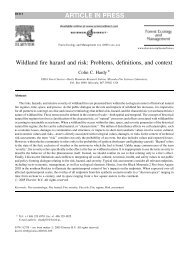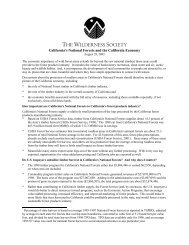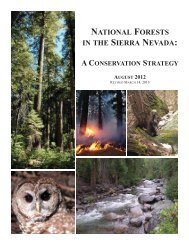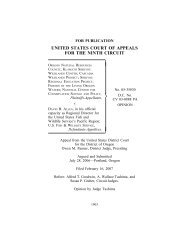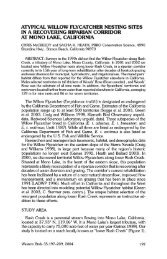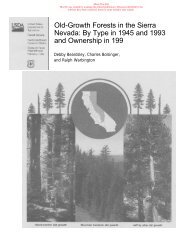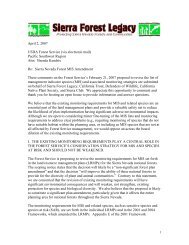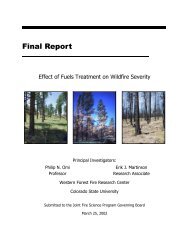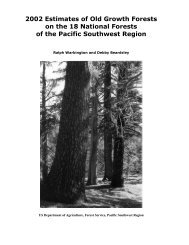1022VOLUME II, CHAPTER 36Frequency Percentagesediments and pollutants from runoff flowing <strong>to</strong> the channelfrom surrounding uplands.Because of the profound effect of dams in reducing naturalhigh flows that support diverse assemblages of riparian vegetation,deliberate high flow releases are increasingly beingrequired from reservoirs <strong>to</strong> maintain riparian habitat. Bot<strong>to</strong>mlandand bank areas that have been cleared for agriculturalor urban uses are in some cases being res<strong>to</strong>red <strong>to</strong> riparianhabitat.These management and res<strong>to</strong>ration strategies are discussedin the following sections.Land-use BuffersFIGURE 36.5Box-and-whisker plots showing the percentage of pixels(100 m x 100 m) containing roads, the percentage of pixelscontaining streams, and the percentage of pixels containingstreams that also contain roads in <strong>Sierra</strong> Nevada Calwaterplanning watersheds (n=141). The latter statistic can berestated as the percentage of streams with a road within100 m of the channel, an index of the potential impact ofroads upon streams, or Road Influence Index (RII).The longest gaps (and thus perhaps the most influentialecologically) were created by reservoirs. USGS 1:100,000 <strong>to</strong>pographicmaps showed more than 150 reservoir gaps at least0.5 km (0.3 mi) long. Highly developed basins such as theFeather and American Rivers had more than 20 reservoirsexceeding 0.5 km (0.3 mi) in length. The <strong>to</strong>tal length of ripariancorridors inundated by reservoirs exceeds 1,000 km(600 mi).The region near streams and other aquatic ecosystems, thatis, the riparian region, is defined in three conceptually distinctways: a transition or eco<strong>to</strong>ne, a discrete habitat or community,and an area of special management or buffer betweenupslope land uses and the aquatic environment. No wonderthat the terms and definitions vary with the context. Scientistsand managers agree on the special nature of riparian areas.Both federal and California forest practice standards orrules specify restrictions and practices intended <strong>to</strong> protectstreams and moderate their disturbance from land use (seeMoyle et al. 1996). The main issue is not the special nature ofriparian areas but rather how much area belongs in this categoryand what activities are acceptable. The ecological functionsand process should be guides <strong>to</strong> use and protection.Riparian ecological functions and physical processes takeFIGURE 36.6MANAGEMENT IMPLICATIONSManagement StrategiesManagement strategies can be used <strong>to</strong> minimize the impac<strong>to</strong>f human activities on riparian areas or <strong>to</strong> res<strong>to</strong>re ecologicalvalues of riparian areas. As described in preceding sections,human impacts <strong>to</strong> riparian systems have occurred by the directremoval or replacement of riparian vegetation or by thealteration of the physical conditions supporting riparian vegetation.The most commonly applied, most straightforward, andprobably most effective strategy is <strong>to</strong> define a riparian managementzone or riparian buffer strip within which vegetationcannot be disturbed and ground compaction is avoided. Thisstrategy serves not only <strong>to</strong> protect riparian vegetation for itsown sake but also <strong>to</strong> maintain the beneficial influence of riparianvegetation upon aquatic habitat through shading, contributionof terrestrial food and nutrients, and filtering ofBox-and-whisker plots showing the percentage of pixels(100 m x 100 m) with streams that also contain roads (RoadInfluence Index) in northern (north of Interstate 80, n=38),central (from Interstate 80 south through the Merced RiverBasin, n=29), southern (south of the Merced River Basin,n=35), and eastern (east of the divide, n=35) <strong>Sierra</strong> Nevadawatersheds. This statistic can be restated as the percentageof streams with a road within 100 m of the channel, anindex of the potential impact of roads upon streams.Frequency Percentage
1023Status of Riparian Habitatplace in three areas at varying distances from the aquatic system:a community area, an energy area, and a land-use influencearea. The size of these areas depends on the localcharacteristics that define them. Any one of the areas may belarger than the others; in other words the three areas are nestedwithin each other, but the order is determined by the characteristicsthat define them rather than an arbitrary hierarchy.One other fact is important in understanding the dimensionsof the entire riparian area: it is not proportional <strong>to</strong> the size ofthe aquatic system. Ephemeral ponds, intermittent streams,and small springs are as important <strong>to</strong> the suite of species thatdepend upon them as large rivers are <strong>to</strong> another suite of species(see Erman 1996). Smaller aquatic systems in forestedenvironments are dominated by the land system. Consequently,the impacts from changes in riparian forest structureand composition and from land disturbance result in majorchanges in the aquatic system (Erman et al. 1977; Minshall1994).The direction of state and federal protection of riparianareas has been based on broad classification of the aquaticsystem—presence of a life-form (fish-bearing vs. non-fishbearing,for example), size (rivers vs. spring runs), or permanence(year-round stream flow in most years vs. temporaryflow in most years). Classification of aquatic habitats for managementin this way does not recognize the connected natureof aquatic systems (upstream-downstream), does not recognizethe needs of riparian-dependent species, and cannot workfor the protection of aquatic biodiversity (which is particular<strong>to</strong> the type of system), or properly assist in the managemen<strong>to</strong>f interconnected land-water systems. Shifting <strong>to</strong> a recognitionof the community, energy, and buffering requirements ofriparian areas will aid in the protection and management ofthe entire riparian system.The Community AreaFor any aquatic habitat there is a suite of species that dependon the combination of land and water. Some spend most oftheir life in the water, some on the land. Most aquatic insects,for example, develop in water but spend a portion of the lifecycle on land—feeding, mating, and resting (see Erman 1996).Alder and cot<strong>to</strong>nwood trees are always associated with nearbywater—a spring, a lake, a stream, or groundwater near thesurface. From a knowledge of the habitat requirements andlife connections of the dependent species, we should be able<strong>to</strong> define the general dimensions of this community area inthe various regions and elevation zones of the <strong>Sierra</strong>. However,the exact requirements and hence the dimensions formany species are unknown. The water shrew (Sorex palustris)is likely confined <strong>to</strong> the virtual stream bank. Beavers (Cas<strong>to</strong>rcanadensis) may move tens of meters from water <strong>to</strong> cut aspenor other trees, as well as cot<strong>to</strong>nwood on relatively flat floodplainsthat extend more than 100 m from low-water channels.The California tiger salamander (Ambys<strong>to</strong>ma californiense),which occurs in the foothills zone (see Jennings 1996), livesin terrestrial habitats near temporary and permanent waterused for breeding. Adults migrate up <strong>to</strong> 129 m (423 ft) (average36 m [118 ft]) and juveniles up <strong>to</strong> 57 m (187 ft) (average 26m [85 ft]) between their breeding site and terrestrial burrows(Loredo et al. in press). Studies elsewhere on amphibians havefound some species that live only in the cool, damp conditionsnear streams and up <strong>to</strong> several hundred meters fromsurface flow (Welsh 1993). Dramatic changes in riparian conditionsdue <strong>to</strong> the logging of forests near headwater streamshave greatly reduced populations of riparian-dependent andterrestrial salamanders in the Appalachians (Petranka et al.1994). Thus, <strong>to</strong> provide for the living requirements of thoseorganisms dependent for their survival on the special conditionsof the riparian area, the primary management shouldbe maintenance of these conditions. Even the natural role ofdisturbance, documented in this chapter and others (see alsoKattelmann and Embury 1996) does not require, in most situations,active res<strong>to</strong>ration of the landscape in order <strong>to</strong> securethe habitat conditions necessary for the area.The Energy AreaMajor scientific understanding of the energy linkages betweenupstream and downstream (e.g., the river continuum concept,Vannote et al. 1980) and exchanges between the land area andaquatic systems has emerged in the last two decades (see reviewsby Cummins et al. 1989; Carlson et al. 1991; Murphyand Meehan 1991). Riparian energy areas contribute a yearroundsupply of organic material that ranges from nearly the<strong>to</strong>tal supply of food at the base of the food chain (small forestedstreams and springs) <strong>to</strong> critical quality food (organicmatter transported in<strong>to</strong> larger streams from smaller upstreamsources). Wind-blown seeds and leaves are a significant sourceof material entering meadow reaches with little forest canopy.The type of organic material is also important. Easily decomposedplant material (e.g., parts with a relatively low carbon<strong>to</strong>-nitrogenratio such as alder leaves), material that is slow<strong>to</strong> decompose (such as Douglas fir), as well as terrestrial insectscarried in are needed <strong>to</strong> support an aquatic food webthroughout the year. Flows of energy from the aquatic <strong>to</strong> surroundingterrestrial system (especially emerging insects) isalso substantial (see Erman 1996) The surrounding riparianarea also blocks energy from the sun and reradiation fromthe water (thus reducing temperature changes). And the roleof large organic matter (trees, root-wads, debris dams) is ofmajor importance <strong>to</strong> the structure and complexity of streamchannels, <strong>to</strong> the routing of sediment, <strong>to</strong> the retention of nutrientsupplies, and <strong>to</strong> the diversity of aquatic habitats. The dimensionsof this region vary by the season (leaf fall ofdeciduous plants), by the hydrologic conditions (out-of-channelfloods, size of stream), by the contributing area (large woodthat can fall in<strong>to</strong> the channel, plant parts and insects that blowin), and by the species mix (organic material breaks downand is useful as aquatic food at different times). A useful summaryindex of this area is the slope distance around the aquaticsystem equivalent <strong>to</strong> the height of the site potential tree (i.e.,the height a mature tree can attain given the soil and other
- Page 1 and 2: G. MATHIAS KONDOLFDepartment of Lan
- Page 4 and 5: 1012VOLUME II, CHAPTER 36TABLE 36.1
- Page 6 and 7: 1014VOLUME II, CHAPTER 36TABLE 36.3
- Page 8 and 9: 1016VOLUME II, CHAPTER 36Elevation
- Page 10 and 11: 1018VOLUME II, CHAPTER 36FIGURE 36.
- Page 12 and 13: 1020VOLUME II, CHAPTER 36FIGURE 36.
- Page 16 and 17: 1024VOLUME II, CHAPTER 36conditions
- Page 18 and 19: 1026VOLUME II, CHAPTER 36we can inf
- Page 20 and 21: 1028VOLUME II, CHAPTER 36Hicks, T.
- Page 22: 1030VOLUME II, CHAPTER 36Schimer, F



